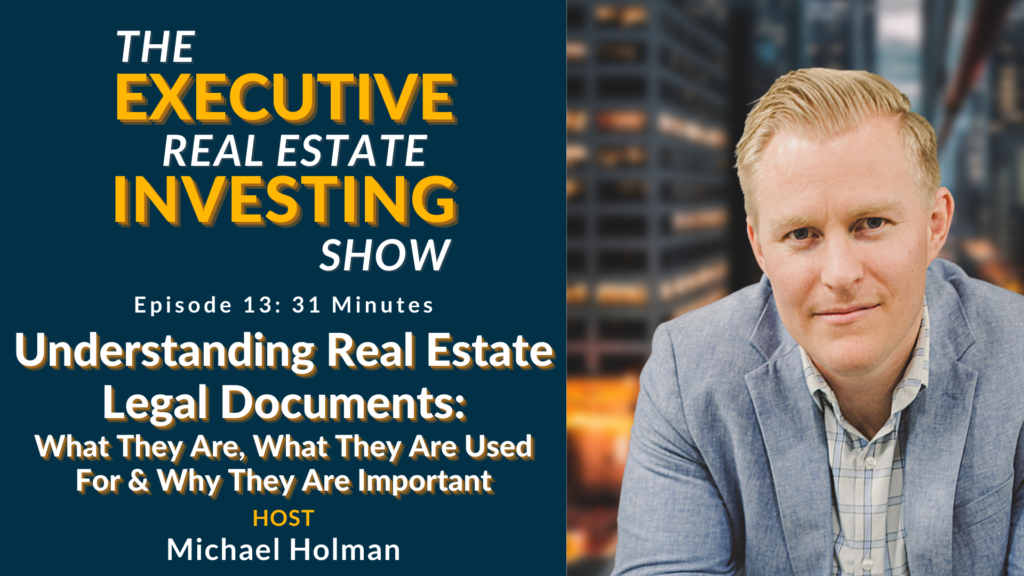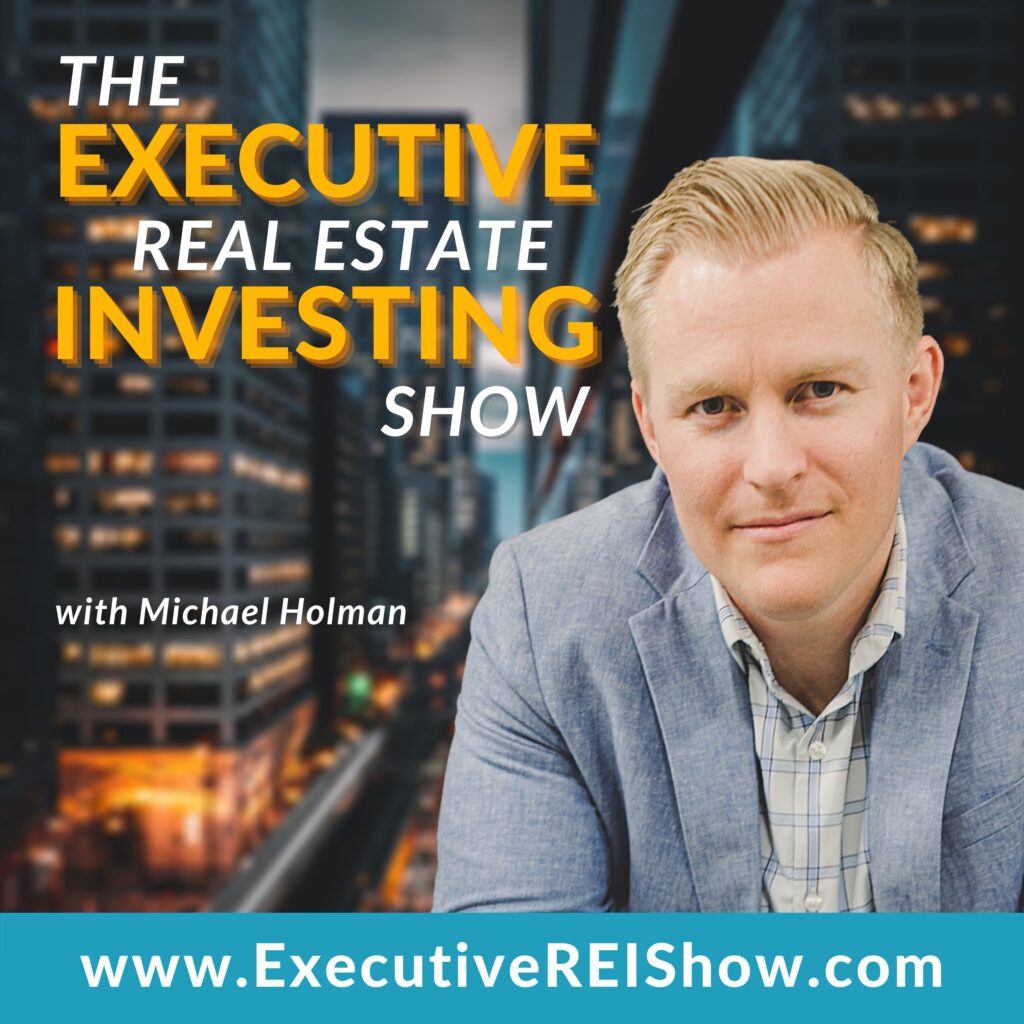
The executive Real estate investing Show
EPISODE 13
Understanding Real Estate Legal Documents: What They Are, What They Are Used For & Why They Are Important
with Michael Holman
- August 30, 2021
EPISODE SUMMARY
This week on the show, host Michael Holman goes into detail about the main legal documents that are required for people who are wanting to passively invest in real estate syndications. Most people investing in real estate don’t understand the legal documents like they should. You don’t have to be an attorney, but you need to have some knowledge about these items.
Listen as he explains why reading the documents can help you avoid bad situations. You want to understand what you are getting yourself into. You don’t want to get into a bad investment, or be with someone who doesn’t understand what they are doing or who you don’t trust.
As always Michael gives his executive tip of the week. You don’t want to miss this episode!
EXECUTIVE TIP
Be Transparent
This week’s executive tip is Be Transparent. Most developers and real estate investors don’t really want to be transparent with their lender. It’s kind of this adversarial relationship. You try to hold as much information in as you can. However, you still need to be cognizant, you need to be aware, and you need to use common sense on what you share and what you don’t share. Because quite honestly there are some things that might not be a big deal that certain groups are going to take as huge deals.
So when and where possible and appropriate, the more transparent you can be the better your relationships are going to be. They are going to be deeper and stronger. When you have deep, strong relationships, people will go out of their way to do more things for you to make your life easier. This is true with lenders, this is true with investors, and this is true with employees. Pretty much anyone and everyone.
LISTEN TO THE PODCAST HERE

The Executive Real Estate Investing Show Podcast
EP 13: Understanding Real Estate Legal Documents with Michael Holman
Listen on
READ THE TRANSCRIPT HERE
Note: Audio transcription has been automatically transcribed
Welcome to The Executive Real Estate Investing Show. This podcast is for you, the busy business owner or executive looking to create generational wealth. Here, we’re going to show you how to do that through real estate investing from multifamily to industrial and everything in between. You will become a real estate investing expert. And now, here’s your host, Michael Holman.
Hello everyone. And welcome to a another episode. So of the executive real estate investing show. I’m your host, Michael Holman. Glad to have you with us today. For another episode, we’ve got a fun episode. It’s all about legal documents. Okay. But before you doze off, you turn off the episode, whatever you’re thinking about doing right now, this is really important stuff.
Okay. So I need you to take a second. And just breathe. This is going to be, yeah, it might feel a little mundane, but this is really, really important stuff. So I don’t want you to fade out just yet. Before we get into all of that though, I just have to go ask every single person, if you have not been to our website, it is time to go to the executive REI show.com.
Once again, that’s executive REI (for real estate investing) show.com. Once you’re there, you can do so many things. Okay. You can subscribe to the podcast, you can get all of the resources and information. You’ve probably been listening to our executive questions episodes, which are personally some of my very favorite episodes.
From the website, you can submit your executive questions is all you have to do. If you want to submit an executive question and get your question read, live on this podcast and answered by me personally, you’re just going to go to www.ExecutiveREIShow.com at the very top on the very top. Right. You’re going to go to the contact us page from there.
You just leave your name and information. Select. I want to submit an executive question, type your question, and I’m going to answer for you. Okay. It’s that easy, but seriously, I’m looking at it right now. As we speak, I am looking at it. There’s so much good information on here, right? You have, you have education, you have all the podcasts, you have the blogs, like I said, I’m literally scrolling through it right now.
You can leave a review, please. If you have none. Go to apple podcasts or Spotify or wherever you listen to your body. Leave us a review. We want to hear from you, right? We want to know how we’re doing. And if you have good things to say, we want to know that if you have bad things to say, keep it to yourself.
No, no, I’m just kidding. If you have criticism, we’re all for that. We want to hear it, but go on, leave us a rating and review that really, really helps us out. And that helps us reach even more people. And we can let more people know about this insanely powerful tool called the real estate investor. Okay.
So like I said, if you haven’t go to the website, www.ExecutiveREIShow.com, one thing I also felt dimension. You can connect or connect with us there. All the social media platforms, posting stuff all the time. Love to have you connect with us, right? You can, you can go on there. You can even apply to be a guest on the show where we’re always taking guests.
And if you’re interested in being a guest on the show and you feel like you have some value to add to real estate investors or potential real estate investor. I’d love to have you on the show. We’ve done it time and time again, and we’ve had some great guests and we got in the past, we got some great guests scheduled in the future, and if you want to be one of those guests, please feel free to sign up.
Okay. That’s all. We’re going to talk about the website, but like I said, if you have not gone to the website now is the time to go www.ExecutiveREIShow.com. And as always, we are going to start this episode off with the executive tip. I kind of feel like we need maybe like a theme song or like a jingle or a ding or something.
Every time we do the executive tip stuff, we’re going to have to look into that. Okay. Maybe in the near future, we’re going to have some little jingle or tone or. A little a spunk and pazazz for the executive tip. We don’t have it this time, but we’ll look to add that in the future, in the future. So this week’s executive tip is be transparent.
I just got off the phone with a lender who is supplying a $40 million loan for one of our projects. It’s a construction loan. And you want to know what they just said to me? I’m not kidding you. This was 30 minutes ago. They said, Mike, this project it’s honestly been a really difficult, it’s really complicated deal, but thank you so much.
For being quick to respond and being transparent with us that has helped us immensely ensure that this still gets done. When is the last time anyone was thanked by their lender? Our, Hey, I almost, I almost fell out of my chair. I’ve almost never been thanked by my lender. Right. But that’s the power of being transparent and you need to be transparent with everyone.
Right? I, in this particular scenario, it was with a lender. I mean, most developers, most real estate investor. They don’t really want to be transparent with their lender, right? I mean, there’s kind of this adversarial relationship. You’re trying to kind of hold as much information as you can. Well, you know, obviously you need to be cognizant, you need to be aware and you need to use common sense on what you share and what you don’t share.
Because quite honestly, there’s some things that might not be a big deal. That certain groups are going to take as huge deals. And it’s just going to be a completely unnecessary tangent to what you’re trying to get done. So I understand that and I recognize that, but when and where possible and appropriate, the more transparent you can be, the better your relationships are going to be.
They’re going to be deeper, stronger. And when you have deep, strong relationships, people will go out of their way to do more things for you, right. And to make your life easier. This is true with lenders. This is true with investors. This is true with employees. I mean, pretty much anyone and everyone. So be transparent.
That is the executive tip. Take it to heart. It’s very, very important. Now getting into our very exciting topic today of understanding real estate legal documents, right? The reason we’re having this episode is I get this question a decent amount. It’s not the most common question I get, but I get it enough that I thought, you know what people need to know and understand this.
Right? And, and on top of just getting the question. I am 99.9% sure that most of the investors out there who are investing in real estate don’t understand the legal documents like they should. All right. You don’t have to be an attorney, but you need to have a common sense about these items. You need to know what they are, what they’re used for why they’re important, because understanding the legal documents.
I mean, that is, that is your key into buying into the real estate, right? I mean, it’s like when you’re buying a stock and you hit buy, you don’t realize it, but you’re agreeing to a whole slew of agreement. Right. You’re agreeing to a ton of stuff. And in real estate we outline it very clearly. Right. And so I want to tell you, this is, and this specifically, just for clarification, this is for people interested in investing passively.
Into a real estate syndication, right. This kind of got sparked because I’m actually currently, I’m about to invest in some more syndications as a passive investor. Right? I’m an active investor. That’s what I do most of the time, but I also invest passively into real estate syndications, and that’s kind of what sparked this.
So really there’s, there’s three main agreements and there’s two that are kind of the. Important that we’re going to spend all of our time talking about, right? The first document, the first legal document is the PPM or the private placement memorandum, right? It’s most commonly known as PPM. We’re going to get into that first and foremost, the second legal document that you got to understand is the operating agreement.
Super important document. Nobody ever looks at it. Right. And it’s like the most important document. So we’re going to get into that a little bit. And then the third one that I’m going to go over and I want to point out specifically is the subscription agreements. All right. So those are the three documents that we’re going to go over today and kind of get, give a in-depth rundown on what to expect when you receive these documents.
All right. So starting off the big one, right? The PPM, the private placement memorandum. These are all over the place, right? If you’re coming in from another private equity type situation or you’re involved in private equity, you’re likely going to already be familiar with the BPM, right? This is not real estate specific.
This is basically for anybody who’s raising money from private, for anyone who’s raising money. From private individuals basically, and that it’s not getting listed on the sec, right? This is a PPM really, really common PR you might’ve seen them before. Like I said, if you’ve done any kind of real estate, private equity, you know, anything like that, you’ve seen them.
I mean, I’ve, I even consulted with a group that was starting a new restaurant, they needed to raise capital for all of the initial funds. They did a PPM, right? So this, this involves a broad range of industries, but there’s specifically a lot of stuff going on here in real estate. And in real estate syndications, this is a document that you’re always going to see always.
So what is the PPM? You know, why is it in place? Well, this document basically outlines it’s a summary of the investment is what you can think of it as. So this outlines who the sponsor is, this outlines how much the sponsor is raising in capital, this outlines, what they’re using, what they are intending to use it for.
It outlines the risks. This is a really important one, right? It outlines the risks. What are the risks of a suit, of investing in a real estate syndication? Well, to be quite honest, those risks, I mean, if you went straight to the risks, They’re going to sound pretty risky. And it’s because real estate investing is not a riskless investment, right?
It’s not a loan to a national credit tenant. Right. You are dealing with a sponsor, who’s a small group or an individual, and they’re using capital. Invest in real estate, right? That’s there’s risks associated with that, right? There’s risks associated with it. What if the sponsor were to go bankrupt or what if the main person in the sponsorship was to die?
Well, you know, what if, what if the market, the real estate market turns and what you thought was going to be a great investment now you’re kind of hanging on for dear life and trying to preserve capital, right? I mean, these are, these risks are outlined very clearly. In the PPM, right? And this is for everybody’s safety.
Not only do the sponsors want these, in the PPM, because that helps protect them. Right? I mean, they don’t have necessarily complete control if a market turns upside down, turns on its head can turn turns completely upside down. Right. The sponsor doesn’t have control. All right. So the sponsor wants that risk in there, but at the same time, the investors need to understand what those risks are.
Right? The risk section in particular, this is outlining. This use is usually between the sponsor and his attorney, and then going back and forth and saying, these are the most common, the most likely risks that are going to be associated with this investment. That’s super important. I mean, if you were, if you were investing in any kind of investment, I mean, that’s almost, that’s almost like, let’s say you wanted to invest in a stock.
All right. Well, let’s pick on somebody. Let’s pick on, Adobe. You can almost see their headquarters in the background over here, or their, their second headquarters. We’re not, we’re not located in Silicon valley, but we’re in the Silicon slopes, right? So Adobe has their second largest headquarters here in Utah.
And let’s just pick on them. So you wanted to invest in Doby and a stock, right? The resection of a PPM is equivalent to a press. The president, the VP is, you know, the CEO, someone like that calling you up and saying, Hey, I understand you want to invest with us. And that’s great. Here is all of the risks that involve investing in this Adobe stock.
Right. Like that would be nice. Right? They just, and that’s what’s happening in the PPM, right? The sponsor is outlining. They’re working with their attorney to say these are all of the most pressing risks in my market, in my industry and what we’re doing and associated with this investment. So really, really important.
Like I said, it gives a summary, right. It understands how the splits are. Right. Does the sponsor. 20% or 30% of the deal, you know, is it para pursue? What is going on? How are the distributions going to be outlined? You know, what is the water? What is the distribution waterfall look like? How do the investors get their money?
When do they get their money? Do they get it first? And they get it second as it lasts. You know, these are all the things that you’re going to want to know. It usually includes sponsor bios, and it includes. The costs associated with it. The sources and uses is specifically what it’s called, right. Basically saying, this is how much money we’re taking in.
And this is where we think all of that money is going to be used for. Right. Some are really accurate. Some aren’t right. I mean, if you’re, if you’re buying an existing asset, a lot of that stuff is pretty pinned down. If you’re constructing new. Well, it’s a little, you know, it’s a little more loosey goosey, but at the end of the day, That is what they’re anticipating in that moment in time.
This is what they’re trying to work towards. So PPM really important. I mean, these can range in size, right? I’ve seen PPMS from 2030 pages to hundreds of pages. And the reason that they range in size usually is because the exhibits, right? So a lot of times people will skip the exhibits, but I’m going to go in and I just want to give you a list.
Right. And this is an all inclusive, some might have more or less than this, but I want to just give you an idea of the exhibits included in the PPM, right. And briefly talk about them. So a really common exhibit you’re going to see, especially in real estate investing is an investor summary, right? A lot of times sponsors real estate sponsors will go.
And do a presentation investor presentation. Well, a lot of times they’ll take that investor presentation. They’ll turn it into, you know, a summary. So instead of it just being a video format, it’s kind of in a written format and they’ll include that in the PPM. Well, why do they do that? Because the sponsor is wanting you to understand, you know, you’re just gone through this list.
All these giant risks associated with investing the sponsor is usually trying to remind you why the good things. What the good things are about investing in this, in this project and in real estate, in this fund, whatever it may be, right. That’s are some of really important, right? And once again, that’s outlining, Hey, usually they’re going to talk about the market.
They’re going to talk about the asset. They’re going to give pictures, stuff like that. So investor summary is really common. Another common one that you see in some of them are a market study or feasibility study. You know, a lot of times sponsors will put this in there cause it makes the actual PPM shorter.
You know, this varies sometimes, like for, for me, a lot of my market studies that I do are, you know, big can be a hundred, 200 pages. I don’t want to make the PPM that long, but I will include it as an attachment. And, when I send out the piece. Right. So it’s not, I don’t even put it in the actual PPM, but it’s like, here’s the PPM.
The exhibit is the feasibility study, see attachment. Right. And that’s, so somebody that’s just to make it easier to navigate on, but, but feasibility study market study really common, really important. It’s not in every single PPM, but it’s, but it’s in a lot, a few more that I see as an investor. Right.
Investor questionnaires are really common because the sponsor, and the specific investment that he or she is doing has certain restrictions on who’s allowed to invest in. Who’s not allowed to invest whether it’s a 506(b) or 506(c) offering. We’ve talked about that in the past, and we’ll definitely talk about it more in the future.
If you don’t know what that is, that would be a great executive question, right? So, but 506(b) or 506(c) offering and the difference. You can allow certain investors in, on one, you, I have to disallow certain investors on another. And so, and so the investor questionnaire just helps give an idea on the investors, basically a self-examination on who that investor is.
If they’re accredited, if they’re not accredited, Next is the subscription agreement, right? So these we’re going to get into this in more detail later on, but essentially the subscription agreement is all of the, all of the documents that you sign to actually invest. We’ll get into this. Later on, next is the operating agreement.
We’re going to get into this in great detail next, but the operating agreement is. Once again, it is extremely important. I’m not going to go into detail right here. Cause we’re going to get into that in like 30 seconds. We’re going to talk all about this. Lastly, another usual exhibit is ACH information.
This is becoming more and more prevalent, in the PPMS exhibits because to be quite honest, ACH is easier and cheaper for everybody. Right? And so what the sponsor is usually doing a lot of times, the HCH will also include a w nine. Right because the sponsor has, when you invest in a real estate investment, the sponsor has to get your tax information in order to prepare all the K ones.
Right? So they’ll usually get a w nine and the ACH is just to make it easy for everybody, right? At the time you’re signing up, you’re already signing all these documents instead of having to try and go back a year or two years down the road, you know, after construction is complete and you’re getting ready to start distributions.
Go back and tell, ask everyone, Hey, what’s, what’s your ACH information. So a lot of times it’s like, Hey, we’re just going to ask for it upfront. And we’ll confirm, you know, in two years, if this is still where you want the money to go. But that’s why that’s in there most often. And that’s the BPM, right?
I guess that overall investor summary really, really important, right? Essentially, I would be very hesitant to invest in a project. It doesn’t give you a PPM because that is probably going to tell you that you have a very inexperienced sponsor who doesn’t know what they’re doing, and doesn’t even know that they’re supposed to have a PPM, right?
This is for the sec, right? I mean, and this is the document that, you know, if you were to, to, let’s say you invested in a, an investment. And heaven forbid you lost, you know, let’s go to the extreme, you lost all your money. Right. And you’d be pretty ticked. Well, the first thing that you do, you know, you’re like, you know what, that sponsorship, that sponsor really messed up.
I’m going to Sue that sponsor. Well, the first thing that has to that has to happen is you got to go and check that PPM one. Did they have a PBM two if they had it. What were the risks of investing in that? Did it stay, you were going to lose all, you could lose all your money or, you know, these are the things that you need to know and understand when you’re going into the investment.
And like I said, a lot of times, you don’t need to get too hung up on it. The most important thing on with all of this, right. Is do you trust the sponsor? If you trust the sponsor, then the PPM is really good. You know, it has good information. You know, but, but the sponsor’s likely going to put something in there that basically says you can lose all your money.
And that is to cover the sponsor in case, you know, an act of God, a pandemic, you know, something were to happen that was completely out of their control, right? So that’s the PPM in a nutshell, really important document and really prevalent across multiple industries. If you’re, if you’re investing in a real estate syndication, you’re going to see a PPM.
All right. Next operating agreement. This is one that I feel like is generally skipped over more, right? I mean, it’s usually an exhibit in the PPM. It’s long. It’s got a bunch of legalees. It’s not that fun. Right. But the operating agreement is the nuts and bolts of how your investment actually works. Right.
The PPM is like a summary agreement, but the operating agreement, that is how things actually are going to run in your investment. Right? So like, you might see a waterfall distribution summarized in your PPM. But that summary came from the operating agreement, the operating agreement. That’s going to talk about your capital account.
That’s going to talk about your dish. That’s going to outline the distribution waterfall, accounting records. K ones. What happens if there’s a dispute? Right. What happens if, what happens if you know, one of the investors goes AWOL and decides to Sue all the other, you know, things like that, is that possible?
Is that not possible? Right. The operating agreement is the nuts and bolts. That is really where the rubber meets the road. Right. And so the operating agreement is really, really important. Like I said, it just skipped over most of the time, but that is something that you need to know and you need to understand, right.
Even if you just read through it just one time, like, just do me a favor, just one time, read through the operating agreement in your next real estate syndication. It. Just getting an understanding, right? Because you just need to make sure that there’s nothing crazy in there, right? There’s nothing that goes against what they S what anyone told you.
Right. If somebody told you one thing and the operating agreement says another, you know, you can hope that their word is good, but at the end of the day, the operating agreement, that’s, what’s going to hold up. Right. That’s what the attorneys and the courts and the judges and everybody bad is what they’re looking at.
Is the operating agreement. They can’t verify if so-and-so told you something outside of that. So operating agreement is really, really crucial. Definitely, definitely recommending you. Look at that. Okay. Last document. We’re going to we’re I promise we’re on the home stretch everybody. The very last document that we’re going to spend, just a brief moment on is a subscription agreement.
So the subscription agreeing. Once again, usually a part of the PPM, the PPM is like the all-encompassing document, right. Usually contains pretty much everything you need within that document. But the subscription agreement that usually is all of the documents you need to actually invest. You need to sign your name XYZ on these documents.
And that is what gets you into the investment. Right. That one’s really important because the subscription right. That is what you give to the sponsor that says I am interested and I, I’m not only interested. I’m now investing. Right. You have a commitment from them. That I am going to fund the amount of money that I said I was going to fund on the subscription agreement.
Right. That is, that is where you get a commitment, right? Some sponsors, are more or less stringent on this and I’ll tell you the more institutional you go, the more stringent you get. So let me give you an example of that. A lot of times when we’re doing a real estate syndication, if we’re doing all retail investors, right?
So all investors. That are investing somewhere between, you know, 75,000 to a million, you know, the average might be like a hundred to 150,000. Okay on an investment, we put less weight on that subscription agreement commitment, because we understand that things change, right. Somebody might invest, something happens and you gotta, you gotta rearrange.
Right. So, so we get that right. If it’s a hundred thousand and we’re doing 15 million, we generally have a way to. Behind everyone. And we can slide someone in new, it’s not the end of the world, but as you get into higher and higher dollar amounts, that’s, if you’re trying to grow, meat becomes more and more important.
So let’s say you had a $15 million investment and you’re going to go build, you know, 200 unit apartment complex. Well, If you’re not getting the money from, you know, a hundred or 150 smaller investors, let’s say you’re getting it from one big institution. They’re going to write you a check for $15 million.
And generally if they’re writing you a check for $15 million, they are bringing it in at the 11th hour, right at the last second. Right. Well, what happens with that commitment? False? You know, there’s, it’s not like there’s just three or four people usually behind that person ready to slide right in the second.
So right. You can kind of see, as you get into higher dollar higher investment amounts, that commitment becomes really important to the point where the sponsor can potentially take legal action against the investor, if they were in an out, right. It’s that important because. Across the board, right?
If someone, if someone pulls, if you’ve got a big institutional investor that was going to invest $15 million, they pull in the 11th hour, let’s say day before closing, they pull out, that has a huge impact. Right? And so, you know, that exists. Like I said, when it comes to smaller investments, most sponsors are really lenient.
Right. We understand things change. Right. But the higher, the dollar amount, the more important that investment to the overall success of the project, the more, the sponsor is likely to hold the investor’s feet to the fire. So that subscription agreement really, really important, especially if you start getting into investments, you know, greater than one to $3 million.
Which I hope all of you get to someday, cause that is a fun place to play in. But if you get into the investments, you know, where you’re making investments of one, two, $3 million, something like that, then just understand as you move up in dollar value, that sponsor is generally going to require a more stringent, follow through of the subscription agreement because that commitment is vital to the success of the.
Okay. That is the show. Like I said, hopefully that wasn’t too bad, but we really needed to get into some of those because people, a lot of people just don’t understand. Right. They don’t, they just get the document, they blindly sign it and they send it off. And I’m saying, no, don’t do that. I mean, if you’re with a new sponsor or something like that, you need to read through these, right.
You need to understand what you’re getting yourself into because you don’t, what you don’t want to do is get your. In a bad investment or somebody who doesn’t understand what they’re doing and who you don’t trust. Right. That is really, really bad spot to be in. And you don’t want to be there. Right? So reading the documents can help you avoid that kind of situation.
Once again, I got to tell you again, if you have not been to our website, www.ExecutiveREIShow.com, go there, check it out, leave us a review. Leave us a question. We want to answer your questions. Connect with us on social media. You’re going to review all the episodes, subscribe to the podcast, all of that@executivereishow.com also.
If you haven’t, please, please, please go to apple podcasts and go leave us a review or wherever you’re listening to the podcast from right? Whether that’s Spotify or apple podcasts, please, please, please go leave us a rating. Leave us a review. We want to hear from you. We always appreciate five stars.
We’re good. With four stars, three stars, two stars, one star, as long as you are giving honest and real feedback. That is okay. That is the most important thing to us. And that’s what we want to hear, but please go leave us a review, excited to hear from you and excited to see you next week on the executive real estate investing show.
Thanks everyone.
Thank you for listening to The Executive Real Estate Investing Show. Ready to learn more? Go to ExecutiveREIShow.com for more episodes and resources to help you create generational wealth through real estate investing. That’s ExecutiveREIShow.com.







